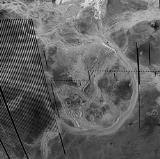
Artemis Corona
Encyclopedia
Artemis Corona is a corona
found in the Aphrodite Terra
continent, on the planet Venus
, at 35°S 135°E.
Named after Artemis
, the virgin goddess of hunting, it is the largest corona on Venus, with a diameter of 2,600 kilometers. It is largely enclosed by the near circular Artemis Chasma
- a circular belt of arc-shaped features believed to be largely of compressional origin.
Artemis is an unusual feature on Venus as it has been interpreted to be the site of plate tectonics operating on a regional scale. There are grabens and compressional arcs which rise above the surrounding plains. As a whole, Artemis is not elevated like other coronae. Regions within Artemis are in fact some 4 km below the surrounding plains. The differences between the highest and the lowest point within Artemis are in the order of 7.5 km.
The central rift region of Artemis has been interpreted as a spreading zone (Britomartis Chasma) which has been offset - with clear signs of strike-slip faulting offsetting the central rift zone. Retrograde subduction is interpreted to occur at the circular arc belts of Artemis Chasmata.
Corona (planetary geology)
In planetary geology, a corona is an oval-shaped feature. Coronae appear on both the planet Venus and Uranus's moon Miranda and may be formed by upwellings of warm material below the surface.-Coronae on Venus:...
found in the Aphrodite Terra
Aphrodite Terra
Aphrodite Terra is a highland region on Venus, near the equator. It is about the same size as Africa, and much rougher than Ishtar Terra.The surface appears buckled and fractured which suggests large compressive forces. There are also numerous extensive lava flows. Channels cross this terrain and...
continent, on the planet Venus
Venus
Venus is the second planet from the Sun, orbiting it every 224.7 Earth days. The planet is named after Venus, the Roman goddess of love and beauty. After the Moon, it is the brightest natural object in the night sky, reaching an apparent magnitude of −4.6, bright enough to cast shadows...
, at 35°S 135°E.
Named after Artemis
Artemis
Artemis was one of the most widely venerated of the Ancient Greek deities. Her Roman equivalent is Diana. Some scholars believe that the name and indeed the goddess herself was originally pre-Greek. Homer refers to her as Artemis Agrotera, Potnia Theron: "Artemis of the wildland, Mistress of Animals"...
, the virgin goddess of hunting, it is the largest corona on Venus, with a diameter of 2,600 kilometers. It is largely enclosed by the near circular Artemis Chasma
Artemis Chasma
Artemis Chasma is the nearly circular fracture in Venus' surface which almost encloses Artemis Corona. The chasma and its associating corona can be found on the Aphrodite Terra continent, at Latitude 35° South, Longitude 135° East....
- a circular belt of arc-shaped features believed to be largely of compressional origin.
Artemis is an unusual feature on Venus as it has been interpreted to be the site of plate tectonics operating on a regional scale. There are grabens and compressional arcs which rise above the surrounding plains. As a whole, Artemis is not elevated like other coronae. Regions within Artemis are in fact some 4 km below the surrounding plains. The differences between the highest and the lowest point within Artemis are in the order of 7.5 km.
The central rift region of Artemis has been interpreted as a spreading zone (Britomartis Chasma) which has been offset - with clear signs of strike-slip faulting offsetting the central rift zone. Retrograde subduction is interpreted to occur at the circular arc belts of Artemis Chasmata.
External links
- A picture of Artemis Corona & it's Chasma from NASA
- A 3-dimensional profile of Artemis region See: http://www.windows.ucar.edu/tour/link=/venus/interior/V_coronae.html&fr=t

